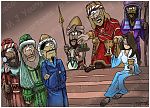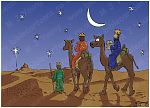Bible Cartoon: Matthew 02 - The Nativity SET 02 - Scene 07 - Herod meeting the wise men
Click on Add to cart button below shopping cart.
Purchased Bible Cartoons do not have watermarks. Links to Cartoons provided on email once purchase is completed.Bible Book: Matthew
Bible Book Code: 4000200702
Scene no: 7 of 15
Bible Reference & Cartoon Description
Matthew 2:7-8 (NLT)
7 Then Herod sent a private message to the wise men, asking them to come see him. At this meeting he learned the exact time when they first saw the star. 8 Then he told them, “Go to Bethlehem and search carefully for the child. And when you find him, come back and tell me so that I can go and worship him, too!”
DRAWING NOTES:
TIME OF DAY:
Unspecified in the Bible narrative. I have set this scene in the late afternoon/early evening.
LIGHTING NOTES:
The sun is going down, but provides light to the right of figures & objects in this scene.
CHARACTERS PRESENT:
From left to right: The wise men, king Herod.
RESEARCH/ADDITIONAL NOTES:
This scene shows the wise men talking to king Herod. They are standing on a marble balcony in Herod’s fortress palace, over looking the city of Jerusalem. I found various plan maps of Jerusalem in Bibles & other resources which show that Herod had a palace/fortress by the western wall of the upper city (Zion). I imagine that he & the wise men are standing on Herod’s balcony, looking out over the city. The 2nd background image (see bottom of page) shows the inside pale stone walls of Herod’s palace fortress, complete with fortified towers, stairs leading down to the gardens & guards marching along the walkways.
Here’s the scene without king Herod & the wise men in the foreground, although this version includes the balcony, pillars, plants etc.

Background of Matthew 02 – The Nativity SET 02 – Scene 07 – Herod meeting the wise men (with balcony)
Click on the colour bar below to view/buy this Background:
Background of Matthew 02 – The Nativity SET 02 – Scene 07 – Herod meeting the wise men (with balcony)
Here’s the scene without king Herod & the wise men in the foreground. In this version I have removed the balcony, pillars, plants etc in the foreground, so we can see more of the palace gardens & walls.

Background of Matthew 02 – The Nativity SET 02 – Scene 07 – Herod meeting the wise men (with balcony)
Click on the colour bar below to view/buy this Background:
Background of Matthew 02 – The Nativity SET 02 – Scene 07 – Herod meeting the wise men (without balcony)
The plants growing up out of ceramic pots around the pillars on the balcony are Passiflora, known also as the passion flowers or passion vines, is a genus of about 550 species of flowering plants, the type genus of the family Passifloraceae. The variety I have drawn is called Passiflora incarnata (aka maypop, purple passionflower, true passionflower, wild apricot, and wild passion vine), which is a fast-growing perennial vine with climbing or trailing stems.
The passion in passion flower refers to the passion of Jesus in Christian theology; the word passion comes from the Latin passio, meaning ‘suffering’. In the 15th and 16th centuries, Spanish Christian missionaries adopted the unique physical structures of this plant, particularly the numbers of its various flower parts, as symbols of the last days of Jesus and especially his crucifixion:
The pointed tips of the leaves were taken to represent the Holy Lance.
The tendrils represent the whips used in the flagellation of Christ.
The ten petals and sepals represent the ten faithful apostles (excluding St. Peter, who denied Jesus three times, and Judas Iscariot, who betrayed him).
The flower’s radial filaments, which can number more than a hundred and vary from flower to flower, represent the crown of thorns.
The chalice-shaped ovary with its receptacle represents the Holy Grail.
The three stigmas represent three nails and the five anthers below them five hammers or five wounds (four by the nails and one by the lance).
The blue and white colors of many species’ flowers represent Heaven and Purity.
In addition, the flower is open for three days, symbolising the three years of Jesus’ ministry.
The flower has been given names related to this symbolism throughout Europe since the 15th century. In Spain, it is known as espina de Cristo (‘thorn of Christ’). Older Germanic names include Christus-Krone (‘Christ’s crown’), Christus-Strauss (‘Christ’s bouquet’), Dorn-Krone (‘crown of thorns’), Jesus-Lijden (‘Jesus’ passion’), Marter (‘passion’) or Muttergottes-Stern (‘Mother of God’s star’).
[Source: https://en.wikipedia.org/wiki/Passiflora]





